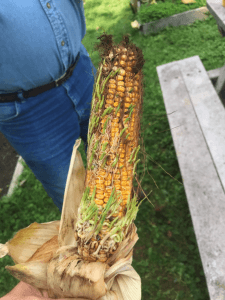Matt Morris, Agriculture Extension Agent
University of Maryland Extension, Frederick County

Fool me once, shame on you, fool me twice shame on me, fool me 365 times and you’re a weather forecaster. It might be a joke, but if you planned anything on the weather this year it is not so funny. When it wasn’t raining and we had a forecast with four days of sun, there was still that nagging 10% chance of rain. As soon as you mowed a field of hay down or the fields got fit to run that 10% rain chance turned into a 100% chance of two inches. It has been quite the season that is for sure. Here are just some of the things I’ve been seeing, hearing, and getting asked about in crops around the area as a result of our rainfall.
I’d say sprout is probably the most frequent question I’ve gotten lately. Sprout is when the seed germinates while still on the cob or in the pod. In corn it occurs when the seed dries down in the 20% range and then goes back above that mark. Warmer temperatures make sprout more likely. Premature sprout, or vivipary as a scientist would call it, has a lot to do with variety. What I have been seeing is that the more exposed an ear tip is, the more likely it is to have sprout. When the tip is longer than the husk it allows water to enter the husk and sit in the bottom, almost like peeling back a shingle on a roof. This obviously will make the seed wet and prone to sprout. How a corn plant holds its ear is a factor too. If a variety drops its ear earlier in the season, water is less likely to enter the husk because it is hanging downward. Post-harvest, drying grain at a higher temperature should eliminate any future sprouting. Due to the potential for broken grain as a result of sprouting, coring a bin is a good idea to blend those partial kernels back in.
With soybeans, sprouting is most often a result of split pods. Earlier this season that soybean plant was determining its pod size. If any stress occurred during that period the plant will tell itself to have a smaller pod. Think back to the roughly four week period of no rain we had in late June and early July. If a soybean was determining pod size then, it will make the pods smaller as it thinks there won’t be enough water for big beans. Boy were they wrong! Once the beans start to form and there is a period of excess moisture, the bean swells and can split the pod open. Later in the season as the bean dries, the split pod allows water in, rehydrating the bean and causing a sprout issue. However, on a year like this, there doesn’t need to be any stress during that pod forming period. There has been so much water that beans swelled more than the average pod could handle. Interestingly, in both corn and beans the seed has to be somewhat mature for sprout to occur. In the immature seed, abscisic acid is present in high concentrations. This chemical prevents the seed from germinating early. As the seed matures, that acid diminishes. Once that abscisic acid is gone, there’s nothing to stop germination.
Lodging is likely to be another concern, especially if weather continues to delay harvest. Corn should stand fairly well, barring any high wind events, but it is soybeans that are more of a concern. There’s two ways that lodging can cause loss: harvest loss or lodging that prevents plants from reaching maturity. With harvest losses, the mature bean falls over due to wind or saturated soils. A 2015 study from VA Tech showed 3-10% yield loss due to lodging. When an immature bean falls down it can reduce the ability of the plant to photosynthesize and ultimately reduce yield. Unfortunately there is no way to prevent lodging of corn or beans. High yielding crops can be more prone to lodging.
Another thing I would definitely recommend is a fall soil nitrate test (FSNT) to see how much nitrogen (N) is left in a field you’ll plant to small grains. More than likely you lost most of the N this summer and without it small grains will struggle this fall. Deficient fall N will reduce root mass and leaf mass, starting the crop off on the wrong foot. I’d argue too little fall N will reduce a small grain’s ability to be a true “cover crop.” A FSNT should be taken with a soil probe to a depth of 8” and about 15-20 cores per field. Make sure you avoid wet spots or other abnormal areas. Dry and mix the sample overnight and then submit it to a lab. We offer FSNT tests here in the county Extension offices for free and can interpret the results for you.
This year has been a challenge and with commodity process the way they are it seems like insult to injury. However, one thing that is true about farmers is that they are the most resilient group of people there is. Next year will hopefully be better and this will all be a learning experience. If you have any questions or want me to take a look at anything you’re seeing in the field this fall please don’t hesitate to call or email me and I’d be happy to come take a look!